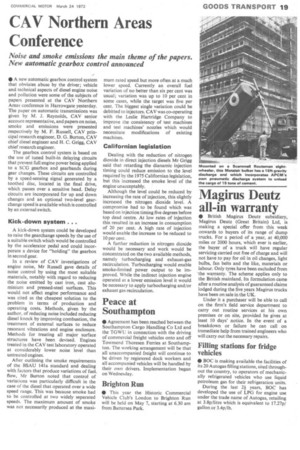CAV Northern Areas Conference
Page 21

If you've noticed an error in this article please click here to report it so we can fix it.
Noise and smoke emissions the main theme of the papers. New automatic gearbox control announced
• A new automatic gearbox control system that obviates abuse by the driver; vehicle and technical aspects of diesel engine noise and pollution were some of the subjects of papers presented at the CAV Northern Areas conference in Harrowgate yesterday. The paper on automatic transmissions was given by M. J. Reynolds, CAV senior account representative, and papers on noise, smoke and emissions were presented respectively by M. F. Russell, CAV principal research engineer, D. G. Burton, CAV chief diesel engineer and H. C. Grigg, CAV chief research engineer.
The gearbox control system is based on the use of tuned built-in delaying circuits that prevent full engine power being applied to a SCG gearbox and gearbands during gear changes. These circuits are controlled by a speed-sensing signal generated by a toothed disc, located in the final drive, which passes over a sensitive head. Delay circuits are incorporated for up and down changes and an optional two-level gearchange speed is available which is controlled by an external switch.
Kick-down system
A kick-down system could be developed to raise the gearchange speeds by the use of a suitable switch which would be controlled by the accelerator pedal and could incorporate a device for "holding" the gearbox in second gear.
In a review of CAV investigations of engine noise, Mr Russell gave details of noise control by using the most suitable materials, notably with regard to reducing the noise emitted by cast iron, cast aluminium and pressed-steel surfaces. This would not affect engine performance and was cited as the cheapest solution to the problem in terms of production and operating costs. Methods, given by the author, of reducing noise included reducing diesel knock by improving combustion, the treatment of external surfaces to reduce resonant vibrations and engine enclosure, Methods for treating all major surface structures have been devised. Engines treated in the CAV test laboratory operated at considerably lower noise level than untreated engines.
After outlining the smoke requirements of the BSAU 141a standard and dealing with factors that produce variations of fuel, flow, Mr Burton noted that control of variations was particularly difficult in the case of the diesel that operated over a wide speed range. This was because smoke had to be controlled at two widely separated speeds. The maximum amount of smoke was not necessarily produced at the maxi
mum rated speed but more often at a much lower speed. Currently an overall fuel variation of no better than six per cent was usual; variation was up to 10 per cent in some cases, while the target was five per cent. The biggest single variation could be debitted to injectors. CAV was co-operating with the Leslie Hartridge Company to improve the consistency of test machines and test machines' nozzles which would necessitate modifications of existing machines.
Californian legislation
Dealing with the reduction of nitrogen dioxide in direct injection diesels Mr Grigg said that retarding the dianamic injection timing could reduce emission to the level required by the 1975 Californian legislation, but this increased the smoke level of the engine unacceptably.
Although the level could be reduced by increasing the rate of injection, this slightly increased the nitrogen dioxide level. A compromise had to be found which was based on injection timing five degrees before top dead centre. At low rates of injection this resulted in an increase in consumption of 20 per cent. A high rate of injection would enable the increase to be reduced to 10 per cent.
A further reduction in nitrogen dioxide would be necessary and work would be concentrated on the two available methods, namely turbocharging and exhaust-gas recirculation. Turbocharging would enable smoke-limited power output to be improved. While the indirect injection engine operated at a lower emission level it would be necessary to apply turbocharging and/or exhaust gas recirculation.




















































































































































